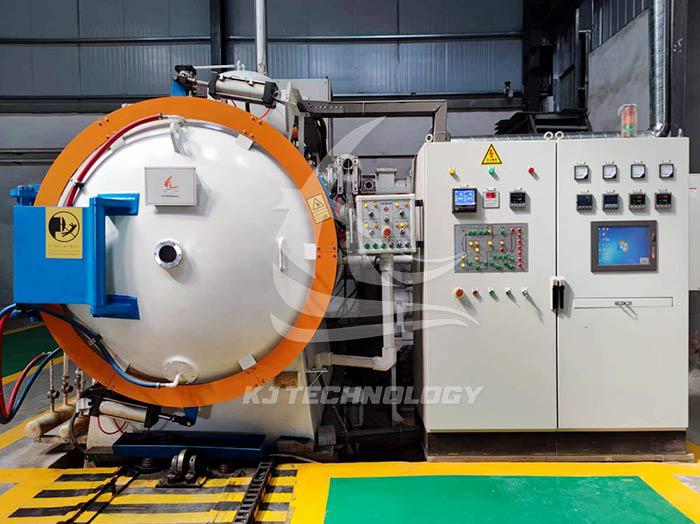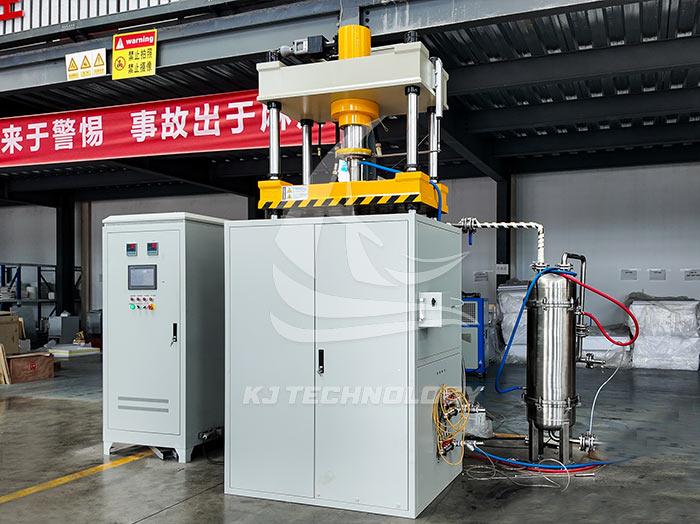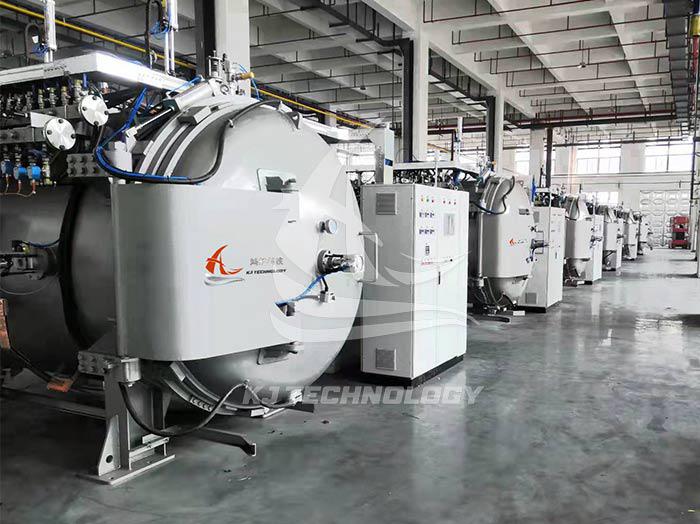Vertical vacuum hot press furnace
 09-18-2025 Author: KJ technology
09-18-2025 Author: KJ technology
Vertical vacuum hot press furnace is a device that heats and sinter metal compounds, ceramics, inorganic compounds, nanomaterials, etc. under vacuum or protective atmosphere. The following provides a detailed introduction from the aspects of structure, working principle, technical parameters, application fields, and operating precautions:
1. Structural composition
The vertical vacuum hot press furnace is mainly composed of furnace body, furnace door, heating and insulation and temperature measurement system, vacuum system, inflation system, water cooling system, control system, hydraulic system, etc.
Furnace body: It adopts a vertical furnace shell, with a cylindrical inner layer made of stainless steel and an outer layer made of carbon steel. The furnace body is divided into two parts, one third of which is the furnace cover (which can be fully opened manually), and the other two-thirds are the fixed furnace body. A jacket is formed between the two layers, which can be cooled by water to remove the heat transferred to the furnace shell, so that the temperature of the furnace wall does not exceed 60 ℃.
Heating, insulation and temperature measurement system: There are various heating methods, such as graphite carbon tube heating, nickel chromium aluminum resistance wire heating, etc. The insulation bucket consists of insulation bucket, reflection bucket, insulation layer and bucket body, which are made of graphite, molybdenum sheet, graphite felt and stainless steel respectively. The temperature measurement system uses tungsten tube tungsten rhenium thermocouples, K-type thermocouples, etc., which can be used for a long time at high temperatures and have high temperature control accuracy.
Vacuum system: composed of oil diffusion pump, Roots pump, mechanical pump, electromagnetic pressure differential valve (to prevent sudden power outage and mechanical pump oil backflow), inflation valve, deflation valve, vacuum butterfly valve, vacuum pressure gauge, bellows, vacuum pipeline and bracket, etc.
Inflation system: composed of various pipelines and valves, equipped with electromagnetic vent valves and pressure sensors. When the pressure inside the furnace exceeds the safe value, it will automatically release gas. A needle valve is installed on the inflation pipeline to control the inflation volume.
Water cooling system: composed of various valves, pipelines, and related devices, equipped with a water cut-off sound and light alarm, which can automatically cut off the heat source or function.
Control system: using thyristor temperature control, equipped with PID function instrument and digital display instrument, with over temperature sound and light alarm function. The PLC touch screen can also be used for automatic control and can retain historical data for analysis of the sintering process.
Hydraulic system: adopting electric input mode, the hydraulic station is equipped with imported proportional valves, pressure sensors, displacement displays, hydraulic cylinders and other related hydraulic devices. The pressure regulation is semi-automatic and can be manually adjusted. The instrument can be set to automatically adjust the pressure and achieve pressure stabilization and maintenance.
2. Working principle
The vertical vacuum hot press furnace reduces the pressure inside the furnace chamber to the required vacuum degree through a vacuum system, and then heats the sample using a heating system. During the heating process, the hydraulic system applies pressure to the sample, causing it to sinter under high temperature and pressure. The inflation system can inject protective gas into the furnace chamber as needed to prevent sample oxidation or other chemical reactions.
3. Technical parameters
The main technical parameters of a vertical vacuum hot press furnace include rated power, power supply voltage, heating method, maximum temperature, number of electrode phases, working area size, head diameter, pressure, pressure fluctuation, displacement accuracy, pressure stroke, hydraulic control, cold state limit vacuum degree of the furnace, temperature control method, temperature control accuracy, atmosphere protection, inflation pressure, pressurization method, etc.
4. Application Fields
Vertical vacuum hot pressing furnaces are widely used in fields such as hard alloys, functional ceramics, powder metallurgy, and new energy manufacturing. For example, in the field of new energy manufacturing, it can be used for sintering lithium battery electrodes and annealing photovoltaic silicon wafers; In the field of powder metallurgy, it can be used to produce high-density products such as high-precision silicon nitride ceramic bearings.
5. Operation precautions
Equipment inspection: Before opening the vertical vacuum hot press furnace, please ensure that the equipment has been stably placed and check the status of all knobs and valves, whether the heating chamber is clean, and whether the water, electricity, and gas sources are working properly.
Electrical control: After starting the electrical control cabinet, please confirm whether there is an alarm indication and whether the digital display of each instrument is correct and stable.
Vacuum pumping: When vacuum pumping a vertical vacuum hot press furnace, please first open the coarse pumping valve, rotary pump, and front valve. When the vacuum degree is below 6.0E+2Pa, turn on the Kailuz pump and diffusion pump. When the vacuum degree is below 0E+0Pa, close the roughing valve and open the main valve. Close all valves and pumps in reverse order.
Emergency situation handling: In emergency situations, when the corresponding knobs and buttons are ineffective, press the "Control Power Switch" button. If the 'control power switch' button is also ineffective, please disconnect the main switch directly.
Daily maintenance: Regularly clean the dust and foreign objects in the electrical control cabinet, check whether all parts of the equipment are intact, especially key components such as heating elements, temperature measuring elements, and vacuum systems.








